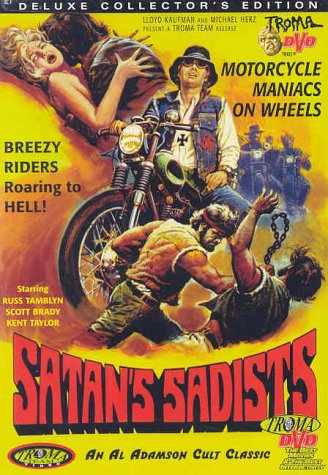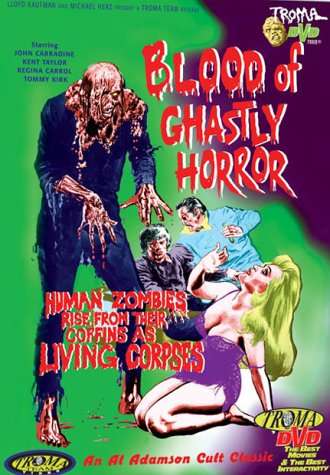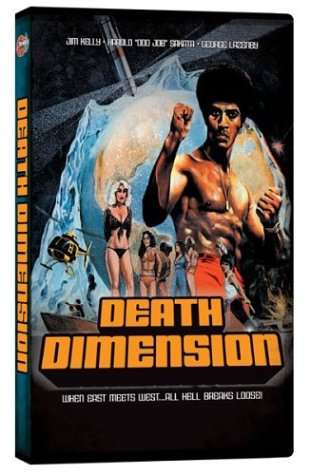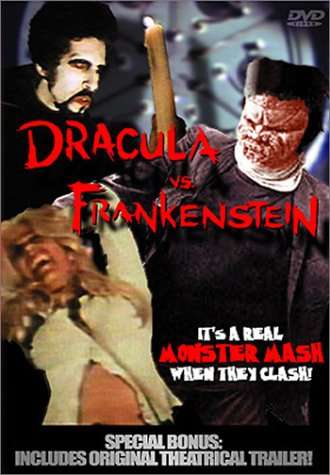|

Independent-International: What
You Didn't Know
(An exclusive interview!)
When it comes to B-movie companies, I have
noticed something unusual. There's plenty of knowledge and coverage for
companies like American International or New World (and the subsequent
Corman-headed spinoffs). But when it comes to
Independent-International, there is both less coverage and knowledge of
the company, even though the company achieved great box office success
with many of its movies. Yes, certain movies from this company like
Dracula Vs. Frankenstein or Satan's Sadists are
fairly well known and loved. But when it comes to the going-ons behind
these movies, there is a remarkable lack of coverage, except maybe for
the occasional brief coverage of cult producer/director Al Adamson.
I was fortunate recently to get in touch
with Independent-International producer Sam Sherman. He was kind enough
to answer a number of questions surrounding his company, films, and
Adamson. Here is the interview:
GREYWIZARD: Can you tell us
about your background before you met Adamson?
SAM SHERMAN: I was born in New York
City and was/am an avid
movie fan since a small kid when I went to see movies in theatres. I
was/am a
big Western and Horror fan, read a lot of comic books and listened to
dramatic
radio shows. Was a big TV fan when that came in of the same kind of
films. I
also had a longtime interest in Photography and Movie-Making, which I
started
with at the age of 8. I did my own little 8MM filming, plus still
photography
and eventually graduated from the CCNY Institute of Film Techniques. I
also am a longtime collector of old movies on 16MM film, way before you
could own films on VHS or DVD. That is how I got The Old Oregon
Trail (1928) produced/directed by Denver Dixon (Victor Adamson)
- Al's father and co-starring Al's mother - Delores Booth. That is how
I got interested in wanting to meet Denver. While going to college I
also worked as a film editor and a writer/editor for James Warren - Famous
Monsters, Wildest Westerns, Screen Thrills Illustrated
etc. I interviewed many actors for stories from John Wayne to John
Carradine etc.
G: How did you meet Al Adamson?
SS: In 1962 I went to Hollywood for
the first time and met many actors and filmmakers I had only known over
the phone and by mail. One I was looking to meet was Denver Dixon,
actor-producer-writer of silent Westerns. I came to interview Denver
for an article in the Warren magazine SCREEN THRILLS ILLUSTRATED. While
visiting him at his home his son came in (Al Adamson) who was then
running a night club in the San Fernando Valley.
We had a brief talk. Al told me his mother
was related to the famous stage actor Edwin Booth. Denver Dixon (born
Albert Victor Adamson (Sr.)
was born in Auckland, New Zealand and went to Australia as a real ranch
hand. He made the first western (silent) in Australia in 1910 -
STOCKMAN JOE. William Morris (agent - formed the big agency later)
booked him in
vaudeville in Australia as "Denver Dick" - in a cowboy roping act
(claiming he was from USA). Denver came to the the US in the early
teens and worked in films on the east coast - Fort Lee etc. - before
going to Hollywood. He appeared in THE SQUAW MAN an important early
feature western done in Hollwood by Cecil B. DeMille. Denver started
making his own films (silent era), discovered stars such as Jean Arthur
and others and owned 5 studios during his career. He continued making
small westerns into the early sound era and later playing small parts
in films to support himself, including films like MY FAIR LADY. He
continued to distribute films theatrically in the south in the 1960s
and taught me theatrical film distribution.
When I went back to New York, I worked with
Denver in distributing the 1934 The Scarlet Letter in
theatrical reissue. Al made a film  (his first he
directed) called Echo Of Terror and brought it to New
York to see me and have me set up distribution on it. (New York was
then the center of film distribution, while most production was in LA).
That was in January 1965 and we bonded and worked to try to sell the
film, which nobody wanted. To attempt to make the film more commercial
Al and I devised his adding Go-Go Musical numbers and more violence to
the film. We changed the title to Psycho A Go-Go. I
later set distribution of this film with Hemisphere Pictures in New
York, a company that I worked for and which made films in the
Philippines. (Note- Psycho A Go-Go is just coming on on
DVD from Troma Entertainment.) (Note: many years later we still had
this failed film and to get some value from it, used footage from it in
a new film we made - Blood Of Ghastly Horror
(a/k/a Man With The Synthetic Brain.) (his first he
directed) called Echo Of Terror and brought it to New
York to see me and have me set up distribution on it. (New York was
then the center of film distribution, while most production was in LA).
That was in January 1965 and we bonded and worked to try to sell the
film, which nobody wanted. To attempt to make the film more commercial
Al and I devised his adding Go-Go Musical numbers and more violence to
the film. We changed the title to Psycho A Go-Go. I
later set distribution of this film with Hemisphere Pictures in New
York, a company that I worked for and which made films in the
Philippines. (Note- Psycho A Go-Go is just coming on on
DVD from Troma Entertainment.) (Note: many years later we still had
this failed film and to get some value from it, used footage from it in
a new film we made - Blood Of Ghastly Horror
(a/k/a Man With The Synthetic Brain.)
We realized we needed our own
distribution company and in September 1968
we started Independent-International Pictures Corp. along with my
friend,
TV distributor and former theatre owner Dan Kennis. I was (and still
am)
president, Dan was Chairman of the Board and Al was executive vice
president. Our first production Satan's Sadists (made
for the new company) was shot in California in October 1968. IIP was
more formally organized in January of 1969, but did not do much until
May 1969 when I went on the road selling Satan's Sadists.
We took films that Al had already shot (unreleased) and modified them
and
put them out after Satan - much of this is well known.
Danny and I ran the company and Al did most (but not all) of the
production
which was done in LA. We also made films on the east coast and were
involved with overseas productions. Al spent most of his time with his
real estate enterprises. IIP also did its own TV and international
distribution (in addition to outside sales firms) and had its own home
video company - Super Video Inc.
The story of what we did (and still do) at IIP is so long and complex
(and
not known to the public) that it would take its own book to explain.
G: What kind of person was Al?
SS: Soft-spoken, polite, easy to
get to know. He was tall and thin and a great athlete. He was a big fan
of the LA Lakers and also played basketball for many years as a sport.
Other than sports, he loved the many dogs he owned, was devoted to his
wife Regina Carrol, and spent a lot of time buying and selling real
estate and building homes. He also owned and operated hotels and guest
ranches. He had grown up in the 1930s depression and at one time
delivered newspapers for a living. He decided to never be deprived
again and this drove him into real estate. At the time of his death he
was a wealthy man. He and I had a wonderful relationship (like the
brother I never had) and we enjoyed being together and working
together. Al always said: "That when we were
both together in the same place (New York or LA) we always made great
things happen."
Al's wife, actress Regina Carrol died in
November 1992 and that started Al on
a long downward emotional spiral - which led to the events which led to
his death. Al disappeared in June of 1995 and I could not find him.
Al's brother Ken and I started a police investigation in June 1995 and
that led to the discovery of his buried body on the premises of Al's
home in Indio, California. It was a very unhappy period for me during
that time and took some time for me to recover (I will never recover
completely). Eventually the murderer (Fred Fulford) was caught and
convicted and given life in prison - no parole.
Al had no formal funeral and was cremated. In September, 1995 I came to
Los Angeles to organize a memorial service for Al, which was done by Al
and
Denver's friend Ewing "Lucky" Brown and myself. We held this at the
Sportsman's Lodge in Studio City in California. Almost 200 people
attended to pay tribute to Al - friends, family and industry
co-workers. What started as very depressing turned out well with many
of us telling humorous stories about the history of Al, whom we all
knew well and loved.
Al Adamson's legacy: No budget was too small, no job too tough. He
would take on any project I wanted him to do. He was a great friend and
great partner and I was lucky to have known him. He was a very skilled
director and always wanted to do bigger and better films, but the
budgets were never there. In my opinion he was capable of making big
budget, high quality films but never had the chance. I was the one who
put him into cult/horror/drive-in movies. I was also the one who wanted
to make them zany and looney. Unfortunately, Al is credited with liking
this type of thing (untrue) and his true talents are not recognized.
But ... at least I know the truth.
G: As a filmmaker, what were
his strengths and weaknesses?
SS: His strength behind the
camera was: first in using good cameramen and
generally good actors and actresses who knew their lines. Al was always
for having a good script and actors well prepared - he did not
improvise on-set.
His great skill was to previsualize a completed scene - how it would
play - how it should be covered from what angles and how it would look
when it was
finally cut together. So he would not run the entire scene from every
angle -
just enough of each angle to give him what he needed to cut together.
That was a great skill to keep the schedule short and economical. Al
was great at staging and making a scene play. My only criticism I had
of his work was the few times he would cast amateurs in acting roles
because they looked right to him for the part and he felt he could make
them work. While it scared me to use anything but pro actors, I must
admit that most of the time Al made those amateurs work really well.
G: Opinions on Al's movies
have wildly varied with both critics and
audiences. What did Al think of his own movies?
SS: Al was well aware of what
was good and bad in his films. He said it was a
problem of low budgets. i.e. "We have some good stuff and we have some
crap," speaking about how scenes in an individual film looked to him. I
would advise re-shooting bad material and Al was happy to do this as
long as I could come up with the money needed to do this. He was always
conscious of what could be done or not be done on a low budget.
G: You and Al managed to
generate significant box office success with your very low budget
movies, despite competing with higher budgeted major studio and B
studio product. What was your secret for success?
SS: We had some of the highest
grossing low budget and drive-in movies. This
considering that our films usually cost less than 1/3 of the budget  of similar of similar
films made at the time by Roger Corman, AIP, Fanfare and others. The
secret of our success was an important part of what I did at
Independent-International Pictures Corp. as president and in charge of
production. I would come up with concepts which were hot at the time
and Al and I would write many of the original stories (sometimes we
each wrote scripts too) to build in strong marketing elements. Then I
would give the films a catchy, easy to identify title, and I did all of
the marketing campaigns - ads, posters, trailers, radio & TV spot
ads etc. I had been in film marketing as a profession and knew how to
make this work. Sometimes Al depended too much on me for this. When we
had a problem in a production, he would say, "You can come up with a
catchy title and do a good campaign and make this film sell well." I
would say yes, but the film must be good enough to screen for the major
circuit buyers and overseas buyers first. This led me to get more money
to fix up problems still in films in the work print phase so the films
became better and would screen better or we would not get them booked.
Each of our films played 4000-6000 US percentage playdates, which was
more than many major studio releases.
There are legends about Al and myself that are not true. That every
film was
a re-shoot or patch-up of something else and not one good consistent
film. It
is true we learned to re-shoot and fix problem (uncommercial) films and
even
took films made by others and changed them into something else. That
was a
marketing decision that I made to make money for the company, not our
overall policy. Too many people know of the work that Al Adamson and I
did from patch jobs like Blood Of Ghastly Horror and Horror
Of The Blood Monsters, which have been successful because of
their craziness, not how great they are. It was always my concept that
if you have a very small budget make the film different by very
bizarre, crazy, looney elements - and this always worked.
Some of our better films were not patch jobs - they are each one
individual,
consistent film which worked well and was successful - and I include-
Satan's Sadists, Angels' Wild Women,
The Naughty Stewardesses,
Black Heat, Girls For Rent (I
Spit On Your Corpse), The Dynamite Brothers, Blazing
Stewardesses and Nurse Sherri.
G: Did the patch jobs, as
well as the frequent renaming and rereleasing of
your movies, ever get you in any kind of trouble with audiences or
anyone
else?
SS: The patch jobs and retitles
never caused any problems. Most patch jobs
were on films that had never been released or hardly ever had been seen
anywhere. Re-titles normally went to different markets. I.e.. a
theatrical film had a tamer title for TV, as they did not want "blood"
etc. in the titles. Other titles
were made for foreign markets as the US title might not be as easily
understood in different cultures. A very few films were reissued later
to drive ins - and played to different audiences as the younger
ones from the first release had usually grown up and passed the drive
in dating stage.
G: Since you have probably
been asked many times about Lon Chaney Jr. and John Carradine, can you
tell any wild stories about Jim Kelly, George
Lazenby, or Harold "Odd Job" Sakata?
SS: I had nothing to do with Death Dimension which
featured Lazenby, Sakata and Jim Kelly. Al did talk to me by phone
during the shooting of the film and told me Sakata could not be
understood and they would have to dub him with another voice. He also
said Kelly did not easily take direction (he did two films with him).
G: Can you tell me of any
movie projects that were planned but ultimately never made?
SS: Gangster Women -
Group of misfit tough women rob banks and so forth.
No Ransom For Regan - Sort of a Dirty Dozen
group saves a kidnap victim.
Gold Fever - Girl hires downtrodden detective
to find father's lost mine.
The Unavenged - Big Western (had been set to
be made as major film) with star cast and familiar plot.
Sequel to Dracula Vs. Frankenstein
Sequel to Satan's Sadists
My dog story Skipper - was badly made as Lost.
The Happy Hobo - Family film about girl and
lost parents with hobo saving her
and a few others which don't come to mind at the moment.
G: What are you up to these days?
SS: I still keep IIP going (now
headquartered in New Jersey - where we had moved  our main office from New York
City in 1978). Dan Kennis is retired in our main office from New York
City in 1978). Dan Kennis is retired in
California. At one time, our good friend Irwin Pizor (formerly
president of Hemisphere Pictures Inc. - Brides Of Blood
etc.) was with our company as vice president and was connected with us
until his death in Florida in the 1990s. Irwin went way back with all
of us as Dan Kennis and he were partners in the TV distribution company
Teledynamics Corp.. Irwin's father William Pizor (one of the early
international distributors) did the international distribution of
Denver's films in the 1920s. I worked for Irwin at Hemisphere in the
1960s. So you will note how all of this ties in. Denver came to New
York in the 1960s and I took him to see Irwin, who was amazed to meet
him again after so many years.
G: What's going on behind the
doors of Independent-International right now?
A- Projects with John Russo (Night
Of The Living Dead, Midnight)
now in development include Escape Of The Living Dead, The
Black Cat
(based on the John Russo novel), Hell's Creation (based
on the John Russo
novel) and some others.
B- UFO- themed projects (which Al Adamson also worked on with me) -
and most of this filmed already.
1- Beyond This Earth - feature film docu-drama about UFO
incursion on Earth.
2- From Other World - UFO documentary
3- I Slept With An Alien - Dramatic cult feature
assembled from footage
already directed by Al Adamson.
4- The Edwards Air Force Base Encounter - based on my
audio documentary of this true story.
C- Remake or sequel to Dracula Vs. Frankenstein.
D- Remake of The Abominable Snowman Of The
Himalayas- Peter Cushing film which we own major rights to.
My deepest thanks to Mr. Sherman for
this interview!
|

